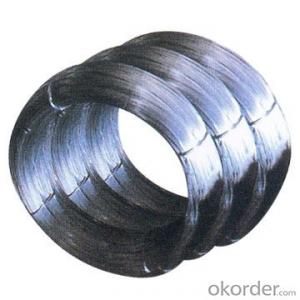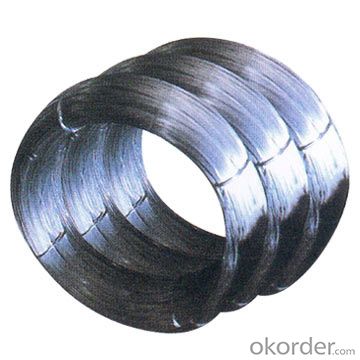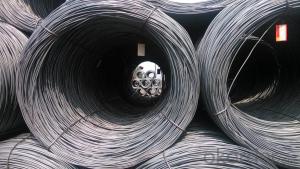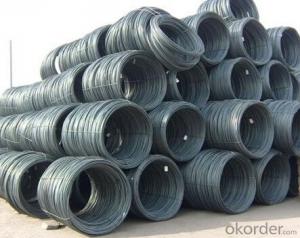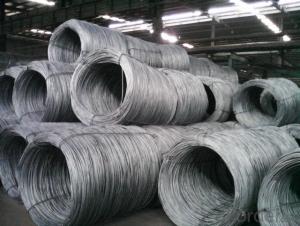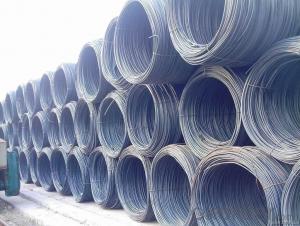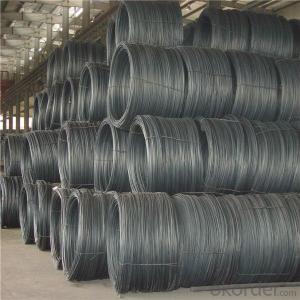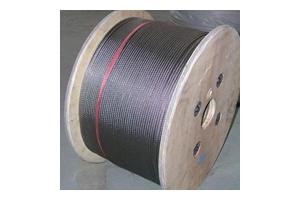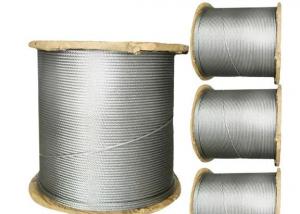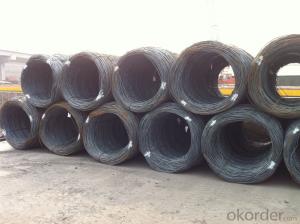Good quality oil temper spring steel wire
- Loading Port:
- Shanghai
- Payment Terms:
- TT OR LC
- Min Order Qty:
- 50 m.t.
- Supply Capability:
- 10000 m.t./month
OKorder Service Pledge
OKorder Financial Service
You Might Also Like
Quick Details
Steel Grade: 45#, 60#, 65#, 70#, 72A, 72B, 82B, 65Mn
Standard: AISI, ASTM, BS, DIN, GB, JIS
- Type: Spring
Application: Construction
Alloy Or Not: Non-alloy
- Diameter range: 0.02-16mm
Standard: AISI, ASTM, DIN, GB, JIS, SUS
Packaging & Delivery
| Packaging Details: | Coils Packing, spools packing, or according to the customers' requirements |
|---|---|
| Delivery Detail: | 10-20days after confirm the order |
Specifications
16mm spring steel wire
1.Diameter range:0.02-16mm
2.Main application:making spring,mattress,wire
carbon steel wire ,Good quality oil temper spring steel wire
| Grade | 201,202,301,304,304L,310S,316,316L,410,430,etc. |
| Diameter | 0.02-16mm |
| Standard | AISI, ASTM, DIN, GB, JIS, SUS |
| Weight | According to the customers' requirements |
| Uses | To produce springs, steel wire ropes, brush and other uses |
| Packing | Coils Packing, spools packing, or according to the customers' requirements |
Terms:
1) Loading Port: Shanghai
2) Delivery term: FOB,CFR, CIF
3) Delivery lead time: 10 working days after received deposit.
4) Payment term:30% by T/T as deposit., balance will be paid by T/T before loading,
5) Quality assurance: Mill Test Certificate is supplied with shipment, third Party Inspection is acceptable.
- Q: How is steel wire rod used in the production of wire fencing?
- Steel wire rod is an essential component in the production of wire fencing as it serves as the raw material for manufacturing the wire used in fencing. The steel wire rod is processed through a series of steps, including drawing, galvanizing, and coating, to transform it into a high-quality wire suitable for fencing purposes. Firstly, the steel wire rod is drawn through a series of dies to reduce its diameter and increase its length. This drawing process helps enhance the wire's tensile strength, making it more durable and resistant to breakage. The resulting wire is then galvanized, a process that involves coating it with a layer of zinc. Galvanization provides protection against corrosion, extending the lifespan of the wire fencing and ensuring its longevity even in harsh weather conditions. After galvanization, the wire may undergo further processing to enhance its functionality for specific fencing purposes. For instance, it can be coated with PVC (Polyvinyl Chloride) to improve its resistance to moisture, UV rays, and other external factors. This coating not only adds an extra layer of protection but also enhances the wire's visibility, making it suitable for applications such as security fencing or animal enclosures. Once the steel wire rod has been transformed into wire and processed accordingly, it is then used to manufacture various types of wire fencing. The wire can be woven or welded to create different designs and patterns, depending on the specific requirements of the fencing project. It can be used for a wide range of applications, including agricultural fencing, perimeter fencing, construction fencing, and even decorative fencing. In summary, steel wire rod plays a crucial role in the production of wire fencing. It undergoes various processing steps to enhance its strength, durability, and resistance to corrosion. The resulting wire is then used to manufacture different types of fencing, providing security, protection, and containment for a wide range of applications.
- Q: What are the common disposal methods for steel wire rod?
- Common disposal methods for steel wire rod include recycling, reusing, and selling to scrap metal dealers. Recycling involves melting down the wire rod to make new steel products, while reusing involves repurposing the wire rod for other applications. Selling to scrap metal dealers allows for the wire rod to be processed and reused in various industries.
- Q: What are the common applications of pre-stressed and oil tempered steel wire rod?
- Pre-stressed steel wire rod is commonly used in construction and engineering applications, such as for pre-tensioning or post-tensioning of concrete structures, bridges, and high-rise buildings. It helps to improve the load-bearing capacity, durability, and overall structural integrity of these projects. On the other hand, oil tempered steel wire rod is frequently utilized in the manufacturing of springs, suspension systems, and other high-stress applications. Its unique properties, obtained through the tempering process, provide excellent resistance to fatigue and ensure reliable performance in demanding industries such as automotive, aerospace, and machinery.
- Q: How is steel wire rod used in the manufacturing of reinforcing bars?
- Steel wire rod is an essential component in the manufacturing of reinforcing bars, also known as rebar. Rebar is widely used in the construction industry to reinforce concrete structures and provide strength and durability. To manufacture reinforcing bars, steel wire rod undergoes a series of processes. Firstly, the wire rod is cleaned to remove any impurities and contaminants. Then, it is heated and passed through a series of rollers to shape it into the desired diameter and form. This process is known as hot rolling. Once the wire rod is shaped, it is then cooled and subjected to a process called quenching and tempering. This involves rapidly cooling the steel to increase its hardness and strength, followed by tempering to reduce brittleness and improve toughness. This heat treatment process ensures that the reinforcing bars have the necessary mechanical properties to withstand the forces and stresses they will be subjected to in construction applications. After the wire rod is shaped and heat-treated, it is cut into specific lengths to produce individual reinforcing bars. These bars are then either fabricated into various shapes, such as straight bars, bent bars, or stirrups, or they can be further processed by threading or welding, depending on the specific requirements of the construction project. The use of steel wire rod in the manufacturing of reinforcing bars is crucial as it provides the strength and structural integrity required to reinforce concrete structures. The high tensile strength of the wire rod ensures that the reinforcing bars can resist forces such as tension, compression, and bending, thereby enhancing the overall strength and stability of concrete structures. Additionally, the ductility and toughness of the wire rod contribute to the ability of the rebar to absorb and distribute stress, preventing cracks and failure in the concrete. In summary, steel wire rod plays a vital role in the manufacturing of reinforcing bars. It undergoes various processes to shape, heat-treat, and fabricate it into the required form, ensuring that the resulting reinforcing bars have the necessary strength, durability, and mechanical properties to reinforce concrete structures effectively.
- Q: What are the standard cleanliness requirements for steel wire rod?
- The standard cleanliness requirements for steel wire rod typically include the absence of surface defects such as scale, rust, or pitting. It should also be free from any contaminants like dirt, oil, or grease. Additionally, the wire rod should meet specific chemical composition and mechanical properties as per industry standards or customer specifications.
- Q: How is steel wire rod used in the manufacturing of wire for electrical heating cables?
- Steel wire rod is used in the manufacturing of wire for electrical heating cables as it serves as the base material for the wire. The steel wire rod is first drawn into the desired diameter and then coated with an insulating material, usually a thermoplastic or thermosetting polymer. This coated wire is then further processed and assembled with other components to form the electrical heating cable. The steel wire rod provides the necessary mechanical strength and stability to the wire, allowing it to withstand the high temperatures and electrical currents required for heating applications.
- Q: How is the mechanical strength of steel wire rod assessed?
- The mechanical strength of steel wire rod can be evaluated using a range of testing methods. One widely used approach involves subjecting a sample of the wire rod to tension until it breaks, known as tensile testing. This test measures the maximum force the wire rod can withstand before failing, also referred to as ultimate tensile strength. Another crucial parameter to consider is yield strength, which indicates the maximum stress the wire rod can tolerate without suffering permanent deformation. Other tests, such as hardness testing, assess the wire rod's surface resistance to scratching or indentation. Popular methods for hardness testing include the Rockwell and Brinell tests. Ductility is another important factor to consider, which measures the wire rod's ability to deform under tensile stress without fracturing. Typically, elongation and reduction of area measurements are used to evaluate ductility. Furthermore, the wire rod's toughness, reflecting its capability to absorb energy prior to fracturing, can be assessed through impact testing. This involves striking the wire rod with a pendulum or falling weight to measure the energy absorbed during fracture. By employing these various testing methods, the mechanical strength of steel wire rod can be thoroughly evaluated, ensuring its suitability for a wide range of applications in industries such as construction, automotive, and manufacturing.
- Q: How is steel wire rod used in the manufacturing of cables and wires?
- Steel wire rod is an essential raw material used in the manufacturing of cables and wires. It serves as the core material that provides strength, durability, and conductivity to the final product. The steel wire rod is first drawn into thinner wires through a process called wire drawing. These drawn wires are then used to create various types of cables and wires by either wrapping them around a central conductor or braiding them together. The high tensile strength and flexibility of steel wire rod make it ideal for transmitting electricity, telecommunications signals, and supporting structures in the cables and wires industry.
- Q: How is steel wire rod used in the manufacturing of wire forms for sliding doors?
- The manufacturing of wire forms for sliding doors relies heavily on steel wire rod. It acts as the main material for constructing the framework and structure of the wire forms. To begin with, steel wire rod is chosen for its exceptional tensile strength and durability, making it ideal for withstanding the constant movement and stress experienced by sliding doors. The wire rod undergoes a series of processes, including drawing and annealing, to enhance its mechanical properties and ensure it meets the necessary specifications. Following that, the steel wire rod is shaped into various sizes and shapes based on the specific design and requirements of the wire forms. This can be accomplished through techniques such as bending, cutting, and welding. The wire rod is manipulated to create the required curves, angles, and dimensions needed for constructing the sliding door wire forms. Once the wire forms are shaped, they undergo further processing to enhance their functionality and aesthetics. This may involve surface treatments like galvanizing or coating to provide corrosion resistance and improve the overall appearance of the wire forms. Lastly, the wire forms are assembled and integrated into the sliding door system. They are commonly used to support the door panels, guide the movement of the doors along the tracks, and provide stability and smooth operation. The steel wire rod ensures that the wire forms can endure the weight of the door panels and withstand frequent opening and closing without deforming or failing. In conclusion, steel wire rod plays a crucial role in the manufacturing of wire forms for sliding doors by providing strength, durability, and flexibility. It serves as the foundation of the wire forms, enabling them to function effectively and contribute to the overall performance of sliding doors.
- Q: What are the different shapes of steel wire rod?
- Steel wire rods come in various shapes and sizes, each designed to have specific properties and applications. Some common shapes of steel wire rods include: 1. Round: This is the most common shape of steel wire rod and is typically used for general-purpose applications such as fencing, construction, and manufacturing of various products. Round wire rods offer excellent strength and versatility. 2. Square: Square wire rods have four equal sides and are often used in applications that require additional strength and stability, such as manufacturing of springs, fasteners, and electrical wiring. 3. Flat: Flat wire rods have a rectangular cross-section and are commonly used in applications that require a wide, but thin, surface area. They are often used in the manufacturing of automotive parts, furniture, and conveyor belts. 4. Hexagonal: Hexagonal wire rods have six sides and are often used in applications that require a higher level of grip or torque, such as in the manufacturing of nuts, bolts, and mechanical components. 5. Deformed: Deformed wire rods have ridges or deformations along their surface, which enhances their bonding properties and makes them suitable for reinforcement purposes, such as in the production of reinforcing bars (rebars) used in construction projects. These are just a few examples of the different shapes of steel wire rods available. The choice of shape depends on the specific requirements of the application, including strength, stability, grip, and bonding properties.
Send your message to us
Good quality oil temper spring steel wire
- Loading Port:
- Shanghai
- Payment Terms:
- TT OR LC
- Min Order Qty:
- 50 m.t.
- Supply Capability:
- 10000 m.t./month
OKorder Service Pledge
OKorder Financial Service
Similar products
Hot products
Hot Searches
Related keywords
